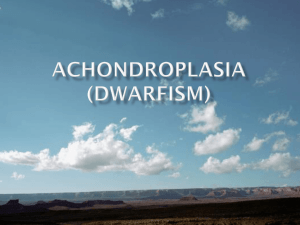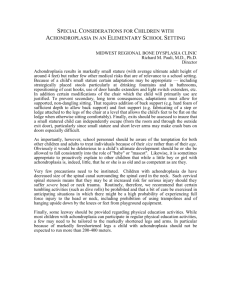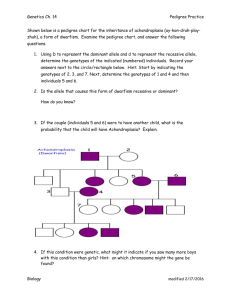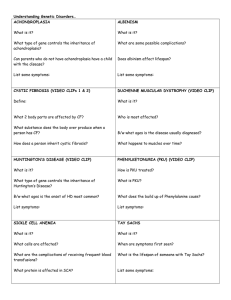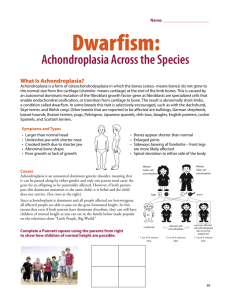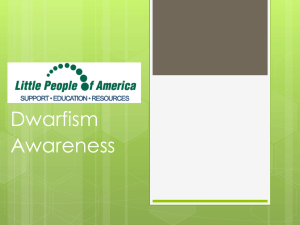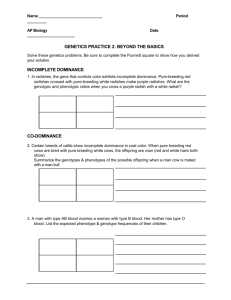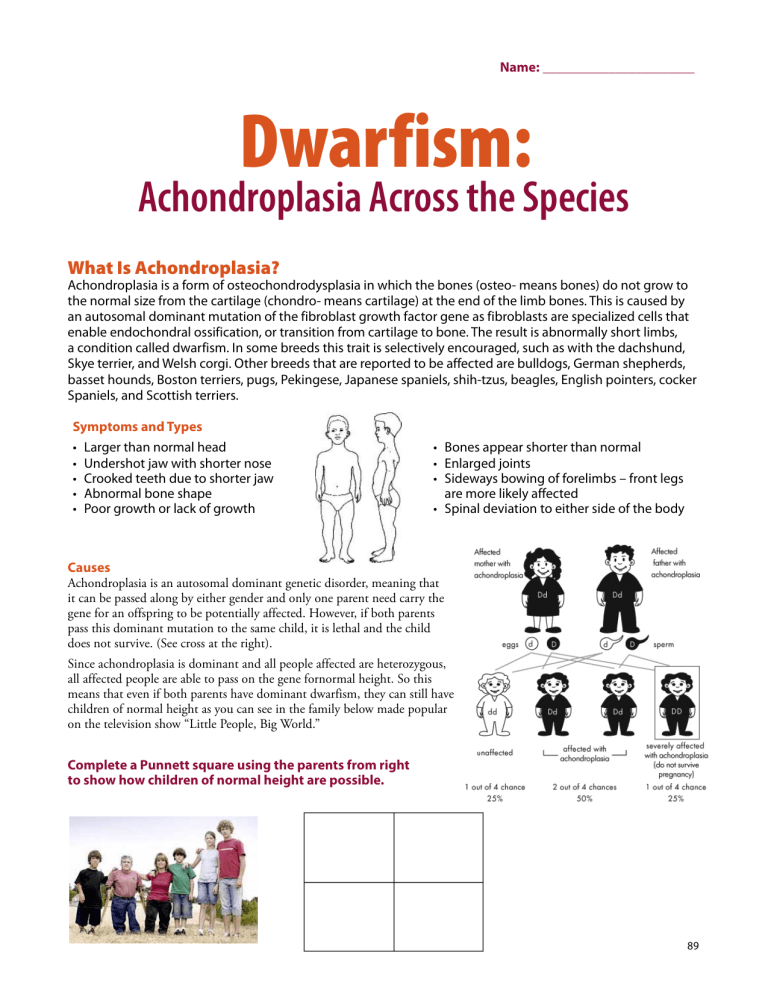
Name: _______________________ Dwarfism: Achondroplasia Across the Species What Is Achondroplasia? Achondroplasia is a form of osteochondrodysplasia in which the bones (osteo- means bones) do not grow to the normal size from the cartilage (chondro- means cartilage) at the end of the limb bones. This is caused by an autosomal dominant mutation of the fibroblast growth factor gene as fibroblasts are specialized cells that enable endochondral ossification, or transition from cartilage to bone. The result is abnormally short limbs, a condition called dwarfism. In some breeds this trait is selectively encouraged, such as with the dachshund, Skye terrier, and Welsh corgi. Other breeds that are reported to be affected are bulldogs, German shepherds, basset hounds, Boston terriers, pugs, Pekingese, Japanese spaniels, shih-tzus, beagles, English pointers, cocker Spaniels, and Scottish terriers. Symptoms and Types • Larger than normal head • Undershot jaw with shorter nose • Crooked teeth due to shorter jaw • Abnormal bone shape • Poor growth or lack of growth • Bones appear shorter than normal • Enlarged joints • Sideways bowing of forelimbs – front legs are more likely affected • Spinal deviation to either side of the body Causes Achondroplasia is an autosomal dominant genetic disorder, meaning that it can be passed along by either gender and only one parent need carry the gene for an offspring to be potentially affected. However, if both parents pass this dominant mutation to the same child, it is lethal and the child does not survive. (See cross at the right). Since achondroplasia is dominant and all people affected are heterozygous, all affected people are able to pass on the gene fornormal height. So this means that even if both parents have dominant dwarfism, they can still have children of normal height as you can see in the family below made popular on the television show “Little People, Big World.” Complete a Punnett square using the parents from right to show how children of normal height are possible. 89 8 – Dwarfism: Achondroplasia Across the Species Achondroplasia in Other Species More and more species have been discovered to have achondroplasia including some dogs, cats, chickens, cattle, rabbits, horses, and more. The results are the same: shortened limbs due to improper bone growth. It is important to understand that this results in disproportionate body parts; some horses are “miniaturized” but this is not an example of achondroplasia as their bodies are proportionate. Some breeders over long periods of time have selectively bred for these mutations as they see them as desirable. Here are a few examples: Dachshunds were originally bred to hunt in small spaces so their short legs were a benefit to their owners. Their name actually means “badger dog.” Pugs have a long history of breeding, back as far as 400 B.C. It was originally bred in China and was a popular companion to monks in monasteries and became a royal favorite in Europe in the 1500s Corgis, due to their small stature, had been brought to Europe around 1107 AD for their ability to herd small livestock like sheep, geese, and ducks. Basset hounds are scent hounds and their short stature, originating from a mutation, allowed them to be the perfect hunter of small prey like foxes. Munchkin cats newer mutation that appeared in the 1940s and has been bred only for its unique look and temperament as a pet. Dwarf horses possess short extremities as the upper leg growth is inhibited. Like most dwarf individuals in other species, head and body are typically normal but limbs are shortened. The dwarfism gene is estimated to exist in more than 25% to around 50% of miniature horses. These dwarfs can live fairly normal lives and often do not suffer as severe health problems from their disorder compared to other species that exhibit dwarfism. Premature arthritis is the most common affliction associated with this phenotype. Unlike humans, achondroplasia is recessive in horses. Chabo chickens have graced the gardens of the Japanese aristocracy for well over 350 years. Historical evidence suggests that the Japanese Bantam originated in Southeast Asia, where it is still raised today. One unusual characteristic of Japanese bantams is extremely short legs. The achondroplasia trait is mainly caused by a single lethal gene, and all Japanese bantams are heterozygous. When the bantams are bred, 25% of the embryos receive two mutant alleles and die before hatching. 50% of the embryos receive one mutant allele and one wild type allele and are shortlegged. The remaining 25% receive two wild type alleles and have legs that are longer than the heterozygous dwarves. When the long-legged birds are bred together, they never produce offspring with short legs. 90 Zoo Genetics: Key Aspects of Conservation Biology 8 – Dwarfism: Achondroplasia Across the Species Achondro-Practice Read each of the situations and complete the cross for each species according to the information provided. Use D/d. 1) David Rogers, author and well-known breeder of rare fowl, has Chabo chickens that he would like to pair. He would like to produce a number of chicks this year including some Chabo chicks and some normal chicks. He wants to avoid any DIS (Dead in Shell) chicks as these would possess two alleles for dwarfism (DD). How can he avoid this? Complete a cross below where he can completely avoid producing any eggs that are homozygous for achondroplasia. Genotype % of offspring: _______ Phenotype % of offspring: _______ Ratio: _______ 2) Rogers has also bred long-legged and short-legged varieties of Chabo chickens where medium-legged chickens are the intermediate phenotype. He has experimented many years in the breeding of different phenotypes. Here is his data: Parent Genotypes Offspring Genotypes Long-legged x Long-legged Long-legged Long-legged x Short-legged Medium-legged Short-legged x Short-legged Short-legged Cross two medium-legged Chabos. Genotype % of offspring: _______ Phenotype % of offspring: _______ Ratio: _______ Can you have pure-breeding Medium-legged Chabos (that would produce all medium-legged chicks)? ________________________________ Why or why not? _________________________________________________ ________________________________________________________________ What type of dominance appears to influence leg length? ______________ _________________________________________________________________ Zoo Genetics: Key Aspects of Conservation Biology 91 8 – Dwarfism: Achondroplasia Across the Species 3) A rancher specializing in racehorses has many buyers for her famous horses. She breeds two of her horses together over serveral years and, after two successful breedings, unexpectedly produced a dwarf pony. How did this happen? In the Punnett square provided, illustrate how this must have occurred. Genotype % of offspring: _______ Phenotype % of offspring: _______ Ratio: _______ 4) Using the diagrams below, answer the questions that follow. a)What is the genotype for a homozygous horse of normal height and stature? __________________________________ b)What is the genotype for a dwarf horse? ______________________________________________________________ c)What is the genotype for a heterozygous horse? _________________________________________________________ d)What is the resulting ratio when two heterozygotes are crossed? _____________________________________________ e)What would be the phenotypic outcome of a cross between two dwarf horses? _________________________________ _____________________________________________________________________________________________ 92 Zoo Genetics: Key Aspects of Conservation Biology 8 – Dwarfism: Achondroplasia Across the Species f)Using the pedigree at the right, explain why inbreeding was more likely to produce a dwarf horse than outbreeding. __________________________________ _____________________________________________ _____________________________________________ _____________________________________________ _____________________________________________ Highly Valued Genetic Disorders? What makes dogs small There are three common and valued genetic conditions in dogs that result in stunted growth: pituitary (ateliotic) dwarfism which results in proportional miniatures, micromelic achondroplasia which results in only shortened limbs, and brachycephalic achondroplasia which shortens the head. All of these conditions are genetic disorders and all of them are definitive features of some breeds, often in combination. These disorders may have started out as random mutations, but they are no longer accidental and unwanted as they are written into the breed standards as required traits. The breed experts don’t want to breed these conditions out of the genetic line, as they demand they breed true, producing more of the same. Most of the toy breeds are ateliotic dwarfs. These include Chihuahuas, Boston terriers, Italian greyhounds, Maltese, Miniature pinschers, Miniature spaniels, Pomeranians, toy poodles, Yorkshire terriers, and more. This form of dwarfism is caused by a deficiency in somatropin which results instunted growth of all somatic cells in the body. Ateliosis is a recessive allele. Achondroplasia only truly affects limb development as the literal translation from the Greek is as follows: “A-“ meaning “no,” “chondro” meaning “cartilage” and “plasia” meaning “growth or change.” Thus, the literal meaning of Achondroplasia is “Defective growth of cartilage” and that’s pretty much what it is. In general, it serves as the name for a cluster of similar disorders of the cartilage and bone (osteochondrodysplasias). This means the cartilage at the end of the limb bones doesn’t ossify into bone, leaving them disproportionately shorter than the rest of the body. The most obvious effects of Achondroplasia occur in the long bones of the leg and “micromelic” means “short limbs.” Micromelic breeds include Basset hounds, bulldogs, Corgis, dachshunds, Lhasa apsos, Scottish terriers, Shetland sheepdogs, among others. Micromelic achondroplasia is a dominant allele. Another form of Achondroplasia that doesn’t lead to what we commonly consider dwarfism but which likewise results in insufficient growth of bone is Brachycephalic achondroplasia which shortens bones in the skull. In dogs, shortening of the mid-face and maxilla (upper jaw) and shortening of the mandible (lower jaw) are inherited separately. Boxers have a shortened upper jaw, but their lower jaw is normal and they are normal sized in all other respects, whereas Boston Terriers have both upper and lower brachycephalism and are also ateliotic dwarfs, so they are proportional but small with flattened faces. Zoo Genetics: Key Aspects of Conservation Biology 93 8 – Dwarfism: Achondroplasia Across the Species Bulldogs have midface and upper jaw brachycephaly so their lower jaw juts outand they have trouble breathing; they also have micromelic achondroplasia as their legs are short and bowed while their trunk is not significantly different than other dogs of that size. Miniature dachshunds carry both forms of body dwarfism, but their faces are unaffected. And what do you get when you combine all three disorders? A Pug. The most completely achondroplastic dog breeds are the toy imports of EastAsia origin (bracycephalic + micromelic achondroplastic + ateliotic) and include the Pekingese, the Shih Tzu, and the Pug. The body-forms of these triply achondroplastic breeds represent the simultaneous superposition of all three varities of achondroplasia – micromelic (limbs), maxillary (upper jaw), and mandibular (lower jaw) – on a smaller frame. Thus, the Pug’s disproportionately stumpy legs that tend to bow result from micromelic achondroplasia. The Pug’s bulging forehead (frontal bossing), large, bulging eyes (exophthalmos), and short midface (midface hypoplasia) all reflect maxillary achondroplasia. The Pug’s short lower jaw expresses mandibular achondroplasia. The Pug’s extraordinarily flat face and crowded teeth are a result of the simultaneous expression of both maxillary and mandibular achondroplasia. These disorders exist with other health complications sometimes present. These include luxating patellas (kneecaps that pop out of joint), arthritis, cataracts, and shortened lifespans. But, none of these disorders can be removed from breeds without fundamentally altering the breed itself. The Miniature Dachshund would simply be a Dachshund if you removed the pituitary dwarfism, but most of the other dogs no longer have a perfect corresponding wild type breed. After centuries of breeding for these traits, these traits are here to stay as a pug wouldn’t be a pug without the traits that make it a pug. Now watch the following video clip on selective breeding/artificial selection: http://www.hhmi.org/biointeractive/dog-breeding What is selective breeding, also known as artificial selection? _________________________________________________ Many dog breeds have been well-documented over time. Using the approximate dates provided for which each breed was first recognized, arrange them appropriately on the timeline below and answer the following questions. Based on the timeline, hypothesize as to when the brachycephaly trait appeared and was selected for by dog breeders. Explain how you came to your answer. Approximate date: __________________ Evidence: _______________________________________________________________________________________ _______________________________________________________________________________________________ Based on the timeline, hypothesize as to when the ateliotism trait appeared and was selected for by dog breeders. Explain how you came to your answer. Approximate date: __________________ Evidence: _______________________________________________________________________________________ _______________________________________________________________________________________________ Based on the timeline, hypothesize as to when the micromelism trait appeared and was selected for by dog breeders. Explain how you came to your answer. Approximate date: __________________ Evidence: _______________________________________________________________________________________ 94 Zoo Genetics: Key Aspects of Conservation Biology 8 – Dwarfism: Achondroplasia Across the Species Your task: Design a breeding plan for each of the situations described below. You may draw Punnett squares and/or pedigrees to illustrate your plan. Situation #1: What could be bred with the dachshund so that the resulting offspring have longer legs? Situation #2: What could be bred with the Boston terrier to help it with its breathing problems? Extension: Draw the resulting offspring of a cross between a Chihuahua and a Bulldog. Label key traits that you think may show up due to this complement of genes. Zoo Genetics: Key Aspects of Conservation Biology 95

